History
The castle was first mentioned in 1188, and its chapel of Saint Martin in 1194. The east and north towers appear to have formed the original core of the fortress; another two hexagonal towers were added later. The north tower had an extensive basement for the storage of provisions, which along with two wells and rainwater cisterns allowed for the withstanding of sieges.
The castle was held in fief by a long series of masters: the Patriarchate of Aquileia, the Counts of Gorizia, the city of Cividale del Friuli, the Venetian Republic, and finally the Habsburgs. It appears to have functioned as a dedicated fortress rather than a residence, and had no permanent civilian population in peacetime, only a large garrison; it also housed a prison. The structure was severely damaged in the earthquakes of 1348 and 1511, but was repaired each time. It was finally abandoned in 1651 by its last owners, the Coronini family, for a new manor in Tolmin itself, though it remained sufficiently intact by 1713 to play a role in the great peasant revolt of that year. The castle is currently in ruins, though parts of it have been restored.
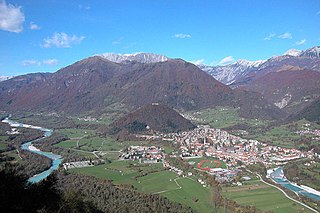
Tolmin is a small town in northwestern Slovenia. It is the administrative centre of the Municipality of Tolmin.

Bodrum Castle is a historical fortification located in southwest Turkey in the port city of Bodrum, built from 1402 onwards, by the Knights of St John as the Castle of St. Peter or Petronium. A transnational effort, it has four towers known as the English, French, German, and Italian towers, bearing the names of the nations responsible for their construction. The castle was completed in the late 15th century, only to be taken over by the Islamic Ottoman Empire in 1523. The chapel was converted to a mosque, and a minaret was added. The castle remained under the empire for almost 400 years. After remaining empty following World War I, in the early 1960s, the castle became the home for the award-winning Bodrum Museum of Underwater Archaeology. In 2016 it was inscribed in the Tentative list of World Heritage Sites in Turkey.
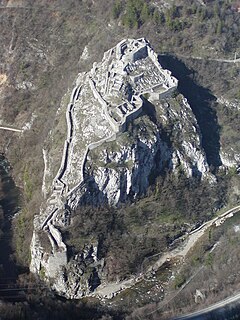
Stari Grad is a fortress near the city of Užice, in central Serbia. Today in ruins, it is an example of typical medieval Serbian architecture. Historians believe it was built in the second half of the 14th century to control movement along nearby roads, and the town of Užice. Stari Grad was declared Protected Monument of Culture in 1983, and it is protected by Republic of Serbia. Though in ruins, the fortress is considered a symbol of Užice.

Ljubljana Castle is a castle complex standing on Castle Hill above downtown Ljubljana, the capital of Slovenia. It is a key landmark of the town. Originally a medieval fortress, it was probably constructed in the 11th century and rebuilt in the 12th century. It acquired its present outline with an almost complete overhaul in the 15th century, whereas the majority of the buildings date to the 16th and 17th centuries. Initially a defense structure and since the first half of the 14th century the seat of the lords of Carniola, it was since the early 19th century used for various other purposes and today is used as a major cultural venue.

Samobor Castle is a ruined castle atop of Tepec hill in Samobor, Croatia. It lies only a 10-minute walk away from the city centre. Remains of the old castle moat are still visible, as well as the massive entrance and most of the walls.
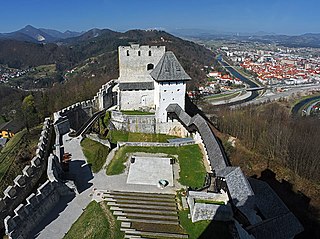
Celje Castle is a castle ruin in Celje, Slovenia, formerly the seat of the Counts of Celje. It stands on three hills to the southeast of Celje, where the river Savinja meanders into the Laško valley. Today, the castle is in the process of being restored. It was once the largest fortification on Slovenian territory.

Sevnica Castle is a Slovenian castle in the Lower Sava Valley. Situated atop a hill, it dominates the old town of Sevnica and offers views of the surrounding countryside.

The Castles of Bellinzona are a group of fortifications located around the town of Bellinzona, the capital of the Swiss canton of Ticino. Situated on the Alpine foothills, the group is composed of fortified walls and three castles named Castelgrande, Montebello and Sasso Corbaro. Castelgrande is located on a rocky peak overlooking the valley, with a series of walls that protect the old city and connect to Montebello. Sasso Corbaro, the highest of the three castles, is located on an isolated rocky promontory south-east of the other two. The Castles of Bellinzona with their defensive walls have been an UNESCO World Heritage Site since 2000.

The Baumkircher Tower, also known as Tabor Castle or Lower Castle, is a defensive tower or small castle located in the town of Vipava in southwestern Slovenia.
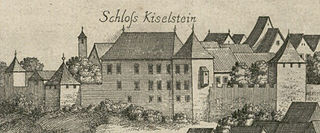
Kieselstein Castle, also known as Khislstein, is a 13th-century castle in the city of Kranj, in the Upper Carniola region of Slovenia.
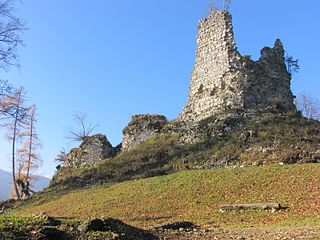
Lipnica Castle, also known as Deserted Castle above the Lipnica, is a castle ruin near the settlement of Zgornja Lipnica in Upper Carniola, above Lipnica Creek, in the Municipality of Radovljica.

Kostel Castle is a castle above the settlement of Kostel in southeastern Slovenia. It is located on a steep hill above the Kolpa River, not far from the Croatian border.

Landskron Castle is a medieval hill castle northeast of Villach in the state of Carinthia, Austria. Dating to the early 14th century, the castle ruins are located on a rock cone of the Ossiach Tauern range, at an elevation of 658 metres (2,159 ft) above sea level. Today Landskron Castle, its falconry centre conducting regular flying demonstrations, and the nearby macaque enclosure are major tourist destinations.
Polhov Gradec Castle is a castle ruin above the settlement of Polhov Gradec, in the Municipality of Dobrova–Polhov Gradec in central Slovenia. It is located on Calvary Hill immediately northwest of the town center.

The Bock is a promontory in the north-eastern corner of Luxembourg City's old historical district. Offering a natural fortification, its rocky cliffs tower above the River Alzette, which surrounds it on three sides. It was here that Count Siegfried built his Castle of Lucilinburhuc in 963, providing a basis for the development of the town that became Luxembourg. Over the centuries, the Bock and the surrounding defenses were reinforced, attacked, and rebuilt time and time again as the armies of the Burgundians, Habsburgs, Spaniards, Prussians, and French vied for victory over one of Europe's most strategic strongholds, the Fortress of Luxembourg. Warring did not stop until the Treaty of London was signed in 1867, calling for the demolition of the fortifications. Ruins of the old castle and the vast underground system of passages and galleries known as the casemates continue to be a major tourist attraction.
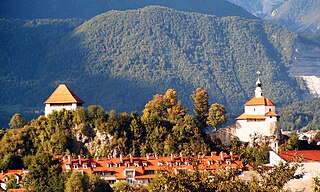
Little Castle in Kamnik, Slovenia, once formed part of a castle constructed in the 11th or early 12th century at the strategic site above the narrow passage near an important trail. The Romanesque chapel of St. Eligius is one of the most important Slovene medieval monuments, despite later alterations, and is one of the oldest of its kind in Europe. The chapel features a wooden ceiling and exquisite fresco paintings. Kamnik's Medieval Days festival takes place at the foot of the castle every June.

Ulcinj Old Town or Ulcinj Castle is an ancient castle and neighborhood in Ulcinj, Montenegro. Today mostly inhabited by Albanians, it was built by the Illyrians on a small peninsula at the right side of the Pristan Gulf, which is part of the Adriatic Sea. Today, oldest remains are the Cyclopean Wall. The castle has been restored many times since it was first built although major changes were made by the Byzantinians, Serbs, Venetians, and Ottomans. The modern city of Ulcinj was built outside of this castle.

Kassiopi Castle is a castle on the northeastern coast of Corfu overseeing the fishing village of Kassiopi. It was one of three Byzantine-period castles that defended the island before the Venetian era (1386–1797). The castles formed a defensive triangle, with Gardiki guarding the island's south, Kassiopi the northeast and Angelokastro the northwest.
Kurvingrad or Koprijan (Копријан), is the ruined fortress which sits above the town of Doljevac on the South Morava river, 11 km south of the town of Niš. The ruins are all that remain of the medieval town of Koprijan from the time of Antiquity, making the fortress over a thousand years old. Today, there are remains of fortifications, but they have not been substantially studied.
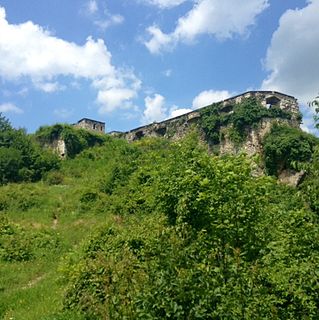
Zvornik Castle, also known as the Old Town of Zvornik and Kula Grad, is a medieval castle located in Zvornik, Bosnia and Herzegovina, on the mountain Mlađevac overlooking Drina Valley. Zvornik fortress is 147 metres (482 ft) above sea level.




















